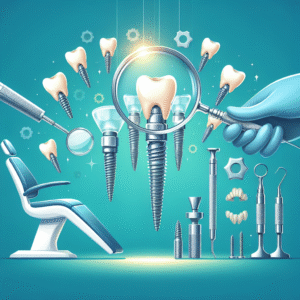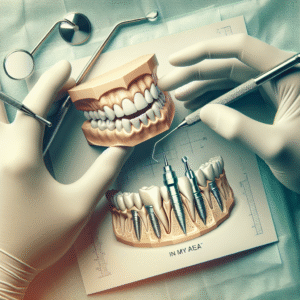All-on-4 Dental Implant Procedure: Pros and Cons
For individuals suffering from extensive tooth loss or severe dental decay, the All-on-4 dental implant procedure has emerged as a revolutionary solution. This advanced technique provides a stable, permanent alternative to traditional dentures by anchoring a full arch of prosthetic teeth using just four dental implants. Unlike conventional methods, the All-on-4 system often eliminates the need for bone grafting for dental implants, making it a viable option even for patients with diminished jawbone density.
In this comprehensive guide, we’ll explore the benefits and drawbacks of the All-on-4 procedure, compare it to alternatives like full-arch dental implants and implant-supported dentures, and discuss innovations such as zygomatic implants and Teeth-in-a-Day / Same-Day Implants.
What Is the All-on-4 Dental Implant Procedure?
The All-on-4 technique involves the strategic placement of four titanium implants in the jawbone to support a full set of upper or lower prosthetic teeth. Two implants are positioned vertically at the front of the jaw, while the remaining two are angled at 45 degrees in the posterior region. This unique configuration maximizes bone contact, often bypassing the need for additional bone augmentation procedures.
Key Features of All-on-4 Implants:
- Minimal Implants Required: Only four implants per arch instead of six or more.
- Immediate Functionality: Many patients receive Teeth-in-a-Day / Same-Day Implants, allowing them to leave the clinic with a fully functional smile.
- Bone Preservation: Angled implants avoid areas with low bone density, reducing the necessity for bone grafting for dental implants.
- Cost-Effective: Fewer implants and surgeries translate to lower overall costs compared to traditional full-arch restorations.
Pros of the All-on-4 Dental Implant Procedure
1. Faster Treatment Timeline
Unlike conventional implants that require months of healing, All-on-4 often enables Teeth-in-a-Day / Same-Day Implants. Patients can enjoy immediate aesthetic and functional benefits, avoiding lengthy waiting periods.
2. Reduced Need for Bone Grafting
Many patients with significant bone loss are not candidates for standard implants without undergoing bone grafting for dental implants. The All-on-4 system’s angled implants leverage existing bone, making it an ideal solution for those with atrophy.
3. Improved Stability and Comfort
Compared to removable dentures, All-on-4 provides a secure, non-slip fit. The implants fuse with the jawbone (osseointegration), preventing slippage and discomfort while eating or speaking.
4. Natural-Looking Results
Modern prosthetic teeth attached to All-on-4 implants are custom-designed to match natural teeth in shape, color, and function, restoring confidence in one’s smile.
5. Long-Term Durability
With proper care, All-on-4 implants can last decades, outperforming traditional dentures that require frequent adjustments or replacements.
6. Cost-Efficiency
Since fewer implants are used and bone grafts are often unnecessary, the All-on-4 method is generally more affordable than full-arch dental implants requiring six to eight implants per arch.
Cons of the All-on-4 Dental Implant Procedure
1. Not Suitable for All Patients
While All-on-4 reduces the need for bone grafts, some individuals with extreme bone loss may still require zygomatic implants, which anchor into the cheekbones instead of the jaw.
2. Potential for Post-Surgical Complications
As with any surgery, risks include infection, implant failure, or nerve damage. Proper aftercare and choosing an experienced surgeon minimize these risks.
3. Higher Upfront Cost Than Dentures
Though cost-effective compared to other implant options, All-on-4 is more expensive upfront than removable implant-supported dentures. However, its longevity often justifies the investment.
4. Adjustment Period
Patients may experience temporary soreness, swelling, or difficulty adapting to their new teeth, though these issues typically resolve within weeks.
5. Limited Customization After Placement
Unlike removable dentures, All-on-4 prosthetics are fixed, meaning adjustments require professional intervention.
Comparing All-on-4 to Alternative Solutions
All-on-4 vs. Full-Arch Dental Implants
- Number of Implants: All-on-4 uses four implants; full-arch dental implants may require six to eight.
- Bone Requirements: Full-arch implants often necessitate bone grafting for dental implants, whereas All-on-4 may avoid it.
- Cost: All-on-4 is typically more affordable due to fewer implants and surgeries.
All-on-4 vs. Implant-Supported Dentures
- Stability: All-on-4 is fixed; implant-supported dentures are removable but more stable than traditional dentures.
- Maintenance: Dentures require nightly removal, while All-on-4 functions like natural teeth.
All-on-4 vs. Zygomatic Implants
- Bone Loss Solutions: Zygomatic implants are used when jawbone density is too low for All-on-4, anchoring into the cheekbone.
- Complexity: Zygomatic implants involve a more invasive procedure and longer recovery.
Who Is an Ideal Candidate for All-on-4?
The best candidates for All-on-4 implants:
- Have significant tooth loss or decay.
- Seek a permanent alternative to dentures.
- Have moderate bone loss but may not qualify for traditional implants.
- Desire Teeth-in-a-Day / Same-Day Implants for immediate results.
The All-on-4 Procedure: Step-by-Step
- Consultation & Planning: 3D imaging assesses bone structure and plans implant placement.
- Tooth Extraction (if needed): Remaining damaged teeth are removed.
- Implant Placement: Four titanium posts are surgically inserted.
- Temporary Prosthesis: A fixed bridge is attached the same day.
- Healing & Final Restoration: After osseointegration (3-6 months), a permanent prosthesis replaces the temporary one.
Maintenance and Care
- Oral Hygiene: Brush, floss, and use antimicrobial rinses.
- Regular Checkups: Visit your dentist for cleanings and implant inspections.
- Avoid Hard Foods: Protect implants from excessive force.
Conclusion
The All-on-4 dental implant procedure offers a transformative solution for those seeking a permanent, stable, and natural-looking tooth replacement. While it boasts advantages like faster recovery, reduced need for bone grafting for dental implants, and cost savings over full-arch dental implants, it’s not without limitations. Patients with severe bone loss may require alternatives like zygomatic implants, and the upfront cost may be prohibitive for some.
Ultimately, consulting with a qualified implant specialist will help determine if All-on-4, implant-supported dentures, or another option best meets your needs. With proper care, All-on-4 implants can restore functionality, aesthetics, and confidence for years to come.
Frequently Asked Questions
Q1: What are the main advantages of the All-on-4 dental implant procedure?
A1: The All-on-4 procedure offers faster recovery, fewer implants needed, immediate functionality, and a cost-effective solution compared to traditional implants.
Q2: Are there any downsides to the All-on-4 dental implant technique?
A2: Potential cons include limited adjustability after placement, the need for sufficient bone density, and a higher initial cost than dentures.
Q3: How long does the All-on-4 procedure take from start to finish?
A3: The entire process, including surgery and placement of temporary teeth, can often be completed in a single day, with permanent prosthetics fitted later.
Q4: Is the All-on-4 procedure suitable for everyone?
A4: While many patients qualify, those with severe bone loss or certain medical conditions may need additional treatments or alternative solutions.




